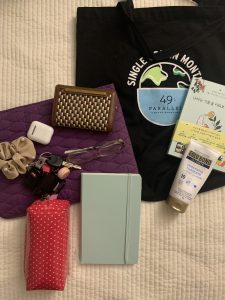
Hello! My name is Julia. I am a MET student currently on my 9th and 10th course this term. I live in Metro Vancouver, BC. For this activity, I chose the book bag that I carry with me to cafes and libraries. This black tote bag contains items that I use daily including keys, wallet, glasses, hair scrunchies, AirPods, laptop, laptop cover, pencil case, Moleskin journal, hand lotion, and a book I’m currently reading. Each of these items serves a specific purpose (e.g. I pull out my wallet to pay for my coffee or put on AirPods to listen to a podcast), while some items serve a purpose when paired together (e.g. laptop case with the laptop, or pen to write in the journal).
These items can be considered ‘texts’ as they communicate information about who I am, although the information is limited and up to the interpretation of the viewer. For example, by seeing the written text ‘Single origin month – 49th parallel coffee roasters’ with the picture of the earth in a mug – one could assume that I’m really into coffee or ethical sourcing practices. Another possible interpretation is that I’m into environments by looking at the reusable tote bag with a picture of the earth. I would say it is a fair assumption. I do enjoy coffee and prefer reusable tote bags (especially since this one is so sturdy and holds many books without stretching). However, I do not know much about ethical sourcing or where coffee comes from. This bag was a gift from a friend who thought I could use a good book bag. Moreover, I often carry a book I’m reading. This week’s book happens to be a collaboration between an illustrator named ‘Worry Lines’ and a Korean writer about ‘self-gardening’. It draws a parallel between growing a garden and self-nurturing. Each page contains an illustration and a short blurb. This item could indicate that I am either fluent in Korean or learning to read Korean. Along with the book, the journal and pencil case could be saying that I like to write or draw to express myself. Cumulatively, these items could be communicating that I spend my time in a coffee shop either reading a book or writing in my journal.
In my bag, digital technologies include a laptop, AirPods, and a cellphone (not in the photo, as it was used to take this picture). I use my laptop and cellphone to communicate and connect in social media, learning space (e.g. Slack, Mattermost, Canvas), and search the internet. I put on my AirPods to listen to music on the Spotify App on my phone or Podcasts. These items indicate a degree of digital literacy and access to greater sources of information (e.g. search engines, online libraries) as well as space to connect and communicate with various people and cultures. Furthermore, these technologies can be used to translate language with a click of a button, watch a movie or series on Netflix, and share photos or videos with friends and family all over the world.
The contents of the bag could indicate that I’m a digitally literate person who enjoys having access to technology and using it when needed, but also appreciate being offline, and reading a book at a cafe while journaling. I would say that is similar to how I view myself. I enjoy having a balance, and when I’m not taking a course or needing to use a computer to work – I prefer being offline and disconnected from technology. This bag does not show my love for the outdoors, as the items are more geared toward my trip to the cafe to read or work on my assignments. If an archaeologist was looking at this bag in the future, he or she may note how pen and paper, along with a paperback was still preferred by some people, while others preferred to use iPad or Kindle. I enjoy the process of writing on a piece of paper for certain tasks like a personal letter or reflective journal, while I prefer to use my laptop for writing essays or professional emails where I have access to grammar and spelling checks, and the ability to edit more easily.